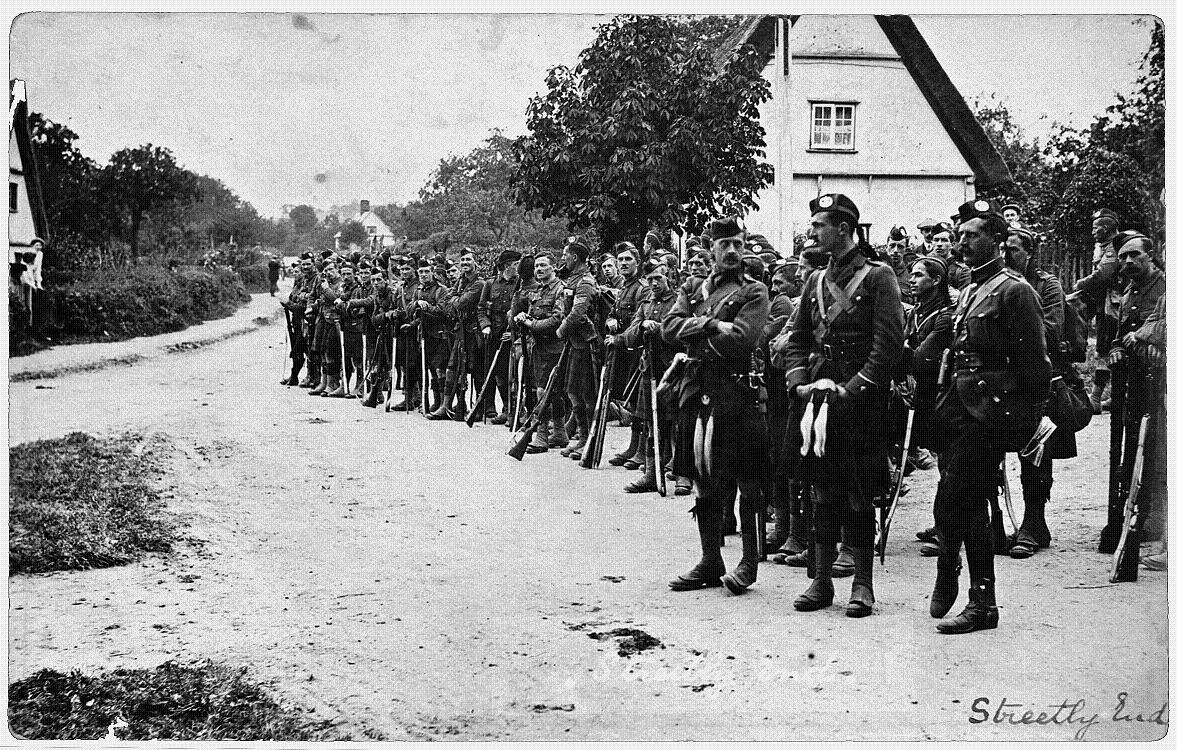Many moons ago while rummaging through the Canadian Archives; I uncovered the Canadian officers’ reports on the British & French Army Manoeuvres of 1912. Canada’s Militia & Defence, submitted the militia officers’ reports, and printed, I turned them into text.
SVP: Owing too the amount words, pages, on this thread I’m providing snippets with links for further reading, viewing of maps and photos.
The term "Army Manoeuvres of 1912," applying to the British Army, without awareness can be confusing, considering the title. Not forgetting the French, German, Swiss, American etc., Army Manoeuvres of 1912 were afoot. Considered as the last exercises of its kind conducted by several countries, armed forces, prior to the outbreak of the First World War. The Army Manoeuvres of 1913 were on a much smaller scale for all forces mentioned. Its true, in the British press etc., dubbed as "Army Manoeuvres." However, the country’s names added in the Canadian Militia Council, official submitted reports, on the "British and French Army Manoeuvres of 1912." The French Army were styled, "Les Grandes Manoeuvres" du Sud-Ouest en 1912, le pas cadencé, marche: 110 000 hommes (men), 500 canons and 50 Aeroplanes. The Kaiser's Army: The Politics of Military Technology in Germany During the ...By Eric Dorn Brose, page 157-159, on German Army Manoeuvres of 1812.
In The Spectator, September 21st, 1912, p.2.
Sir John French pointed out that as it was open to the invaders to deal with the defenders in detail, an important lesson to be drawn from the manoeuvres was the need of the earliest possible concentration of forces. There is no doubt that the aeroplanes did extraordinarily valuable service, but, as has been said, they failed to discover the fourth division. The King, who had followed the latter part of the manoeuvres, was present at the conference, and, in the course of a short speech, said "My inspections during the past two years have satisfied me that the present system of training is conducted on sound lines, and I have especially observed the exceeding keenness of the men and the earnestness of purpose which are apparent in the Army. The aerial work and the rapid concentration of the troops by rail- way, without dislocating the ordinary civilian traffic, and the use of mechanical transport have been the special features of these manoeuvres."
We gather from this that the rapid transport service by motors and the rapidity of the scouting by aeroplanes, speeded up the manoeuvres and caused the general scheme to be carried out well within the time-limit. These are obviously important facts.
PART I.
BRITISH ARMY MANOEUVRES, 1912.
These manoeuvres took place in the Eastern Counties of England, north of London. The general idea, under which the operations were carried out, was that an Invading Army from Redland, whose imaginary frontier coincided with the eastern coastline, was advancing against London, the capital of the Home Territory (Blueland). The positions of the troops on each successive day are shown on the attached outline sketches of the theatre of Operations.
At the outbreak of hostilities the Red Army under Lieutenant General Sir Douglas Haig, consisting of one Cavalry Division and the 1st and 2nd Divisions from the Aldershot Command, about 25,000 strong, advanced across the frontier at Wells and Hunstanton, and commenced to move southwards to threaten London. The political and commercial centre of the Blue country being a decisive factor in the campaign, the Home Defence Forces were hurriedly mobilized and concentrated by rail to intercept the invader on his march towards the Capital. A detachment of all arms belonging to the Territorial Force, then undergoing training at the time, was given imperative orders to defend the important city of Cambridge at all costs in order to cover the detrainment of portions of the Home Army, which were mobilizing at all speed.
The 1st and 2nd Divisions reached Mildenhall and Bury St. Edmunds respectively, after a march of between 22 to 25 miles; each division marched with ease along the single road allotted to it and settled into bivouac, with all its transport within reach, early in the afternoon. Meanwhile the Blue Territorial Detachment, under Major General Lindsay, was busy digging itself into a defensive position north and east of Cambridge, covered by a protecting outpost line with cyclist patrols feeling for the threatening cavalry of the invader.


For further reading and viewing of Maps, and photos see link: Canadian Officers Notes on British “Army Manoeuvres” Sept. 16th - 19th, 1912. Part I. http://wp.me/p55eja-tK
PART II.
MISCELLANEOUS INFORMATION ON BRITISH DIVISIONAL MANOEUVRES, ARMAMENT, TRAINING AND AUXILIARY SERVICES.
THE CAVALRY.
During the Cavalry manoeuvres north of Windsor preceding the inter-divisional manoeuvres, the Southern force of three brigades under General Allenby operated against a skeleton White force. General Allenby's division was armed with the short rifle, sword and lance. The operations commenced with swimming the horses across the Thames River at several points above Windsor. The river at the time was nearly 100 yards wide, with a fairly strong current, being in flood with the heavy rains.
ARTILLERY.
The employment of mobile artillery as demonstrated at the manoeuvres left little to be suggested in the way of improvement of the system of training in Canada……. In the final phase of the battle on the last day of the Army manoeuvres at least half the guns were in the open, otherwise they could not have taken part in the fight. Perhaps the moral is that when large forces are engaged even under the conditions of a modern battlefield, the targets offered are sure to be so tempting as to justify considerable freedom of exposure on the part of the artillery in order to take advantage of them. The Canadian system of training closely follows that of the British and is quite up-to-date. There are few changes to be noted.
INFANTRY.
The march discipline of the Infantry was particularly noticeable, the columns were invariably well closed up, while the right half of the road was kept clear for the passage of traffic past the columns.
Deployments for attack were very varied according to the ground. There were usually several extended lines in order to obtain depth in the attack. Sometimes these lines were in echelon, sometimes in column if there was not sufficient frontage allotted to enable them to extend into echelon. Full use of cover was made where this was available, but if none was at hand it was not considered impossible to advance over open ground in extended order, provided that the advance was covered by artillery fire or infantry fire from neighbouring bodies of troops.

CO-OPERATION BETWEEN ARMS.
Between Artillery and Infantry close communication was kept by telephone, visual signalling, mounted and cyclist orderlies. The senior artillery officer usually accompanied the commander under whom he was serving directly. With small forces told off for a particular task the artillery were usually placed under the Infantry Brigadier. With larger forces, such as a Division, the O.C., R.A., retained control of the guns in the Division, and allotted tasks according to the infantry situation under instructions from the Divisional Commander. The Cavalry Divisions worked invariably under the direct control of the Army Commander, and rarely co-operated closely with the troops in the Divisions.
CYCLISTS.
About 2,500 cyclists were detailed from Territorial Cyclist Battalions, under the Cavalry Commanders on either side. There being numerous good cycling roads, both main roads and country lanes, all over the manoeuvre area, the cyclist units were able to give very effective support to the cavalry by their mobility and fire action.
AIR CRAFT.
The Royal Flying Corps is recruited from all branches of the service and officers are seconded from their own corps for service with it. They wear a distinctive uniform. This corps was represented at both Inter-Divisional and Army Manoeuvres. A, squadron was detailed to either side for the Army Manoeuvres as well as two dirigible balloons. One aeroplane only was allotted to each division during the Divisional Manoeuvres. (Normally, a squadron contains 12 aeroplanes.) Unfortunately during the mobilization of the air craft, and their flights from Salisbury and Aldershot to the points of concentration near Cambridge, two fatal accidents occurred.
For further reading and viewing of Maps, and photos see link: Canadian Officers Notes On British Army Manoeuvres Sept. 16th - 19th, 1912. Part II. http://wp.me/p55eja-ug
Whoever is interested?
Canadian Officers Notes On French Army Manoeuvres Sept. 11th - 17th, 1912.
http://wp.me/p55eja-uw
THK U FR YR TME.
Joseph.


